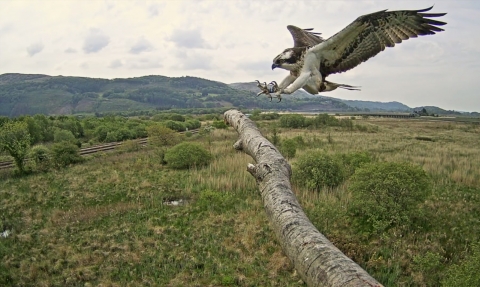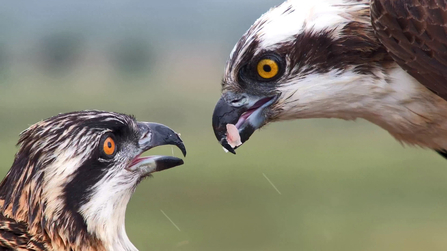
Tegid the Osprey returns to his natal nest on the Dyfi, 21st May 2018 © MWT
Dyfi Osprey Project
About the project
Since 2009, our Cors Dyfi Nature Reserve just outside Machynlleth has been home to the Dyfi Osprey Project. These magnificent fish-eating birds of prey, which were once extinct in the UK as a breeding species, return to our reserve on the Dyfi river each summer to breed, before migrating to West Africa for the winter months.
While they’re here, we use state-of-the-art technology to capture high definition footage right from the osprey nest. This is live-streamed to the high-tech viewing room in our visitor hub, Dyfi Wildlife Centre, and can be watched on our YouTube channel which has more than 15,000 subscribers from all over the world.
Observing these incredible birds as they pair bond, breed, feed their young - who in turn hatch, fledge, hunt and migrate – teaches us so much about them, valuable data which will help further the recovery of ospreys in the UK.
Supporting and conserving the osprey population in Wales, while keeping local communities firmly at its heart, have been the project’s overarching aims since it launched.

Photo: © MWT/Emyr Evans
"The Dyfi Osprey Project has made Cors Dyfi Nature Reserve its home since 2009. Each year we learn more about these incredible birds and help to further the recovery of the Welsh osprey population. Over the years they have brought us joy and tears - sometimes at the same time!
About ospreys
The scientific name for the Osprey is Pandion haliaetus which is derived from the ancient Greek for ‘sea eagle’. Similarly, in Welsh they’re called Gwalch y Pysgod, which translates as ‘fish hawk’ (a nod to their diet). Perhaps confusingly, these birds are neither eagles or hawks but belong to a scientific family all of their own.
In 1916, centuries of persecution, habitat loss and egg collecting took their toll and ospreys disappeared from the UK. Then, after almost 50 years, in 1954 a pair returned to Scotland and began to breed. This led to the start of osprey conservation in the UK. Nest protection, education, translocation projects and careful monitoring have all played a role in the recovery of this amazing species. Osprey projects enable groups and organisations across the UK to support each other and share knowledge to continue to help the osprey population recovery.
In the UK they are a migratory species, breeding here during the summer and migrating to West Africa for the winter months. The osprey population in the UK is slowly recovering and these birds are now protected by law.
It’s estimated there are currently around 300 pairs of ospreys in the UK. These are unevenly distributed with approximately 270 pairs of ospreys in Scotland, around 25 pairs in England and 5 pairs in Wales.
About the Dyfi Ospreys
In 2007 we erected an osprey nest platform on our Cors Dyfi Nature Reserve in response to an increasing number of osprey sightings each spring and autumn. By 2009, there was only one occupied osprey nest in Wales, 30 miles north of the Dyfi in the Glaslyn Valley. On 22nd April 2009, however, the Dyfi Osprey Project opened its doors for the first time and Wales had its second osprey project.
While no breeding took place during those first couple of years, in 2011 our first male Monty (named after Montgomeryshire) was joined by a young female, Nora. Nest cameras enabled us to witness the arrival of the first osprey eggs and chicks on the Dyfi for centuries!
Fortunately, ospreys have bred on the Dyfi every year since. We give 'our' ospreys names to help us keep track of who’s who and to make it easier to explain their lives to people - because we believe that education is At the heart of conservation. All the chicks born on the Dyfi are named after Welsh rivers or lakes.



